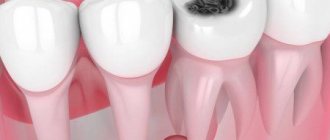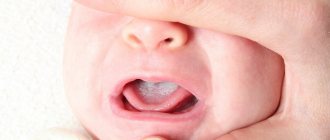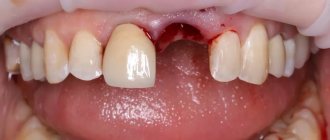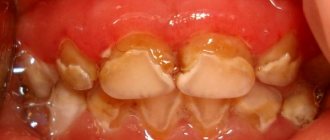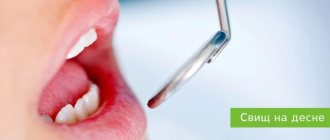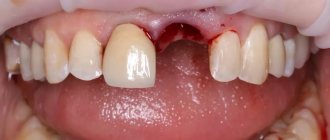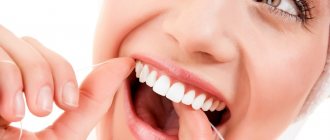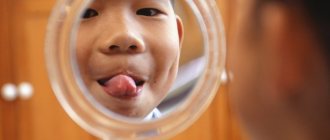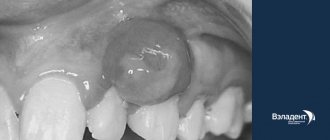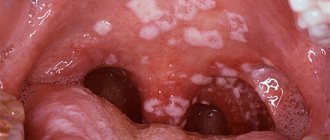01.12.2019
One of the rather unpleasant and dangerous situations for a child’s health associated with dental diseases is the formation of an abscess on the baby’s gum. This situation requires an immediate reaction from the parents, as it can lead to unpleasant consequences.
Why and how an abscess appears on the gum
The main reason for the formation of ulcers in the gum tissue of children is their infection, which can occur as a result of:
- Untreated caries of a baby tooth, causing pulpitis.
- Poor quality dental treatment (if the doctor installed a filling on an untreated tooth).
- Infection in a cyst-like structure that appears at the site of tooth eruption.
- Lack of treatment for pulpitis of a permanent tooth.
- Infection in the gum after injury by any sharp object.
Most often, the formation of an abscess on the gum is caused by caries. The first stages of this disease often go unnoticed, so the infection makes its way inside the tooth. Once it reaches the root, toxins begin to penetrate the tissue and cause inflammation of the gums near the root. Since bacteria are the cause, pus is formed during this inflammation. It comes out under the mucous membrane of the gums, which looks like a purulent sac.
Treatment of abscesses and abscesses in a child
Depending on the nature and cause of the abscess, the doctor will choose the appropriate method of treating the lump on the gum. Most often this is:
- opening and cleaning of pus;
- treatment of caries or removal of a tooth if it is severely damaged and cannot be restored.
In this case, an abscess over a baby tooth can often be eliminated only with the removal of the tooth itself. This is an undesirable process, but it may turn out that it is impossible to fix the problem in any other way.
When treating ulcers in children, the doctor is always guided by the fact that soon the milk teeth will be replaced by molars. The formation of a cyst or abscess over a baby tooth can affect the future molar, so sometimes the decision to remove a tooth is actually advisable.
After the procedure, the child is prescribed antiseptics for home use.
Main symptoms
The appearance of a purulent formation on the gum is accompanied by quite specific symptoms. First, the child will notice a feeling of fullness in the gum, and a little later, a small reddish swelling will appear in the place he indicated.
Gradually its size will increase, and a white dot will become noticeable in the center of the cone. It indicates the appearance of pus inside the gums. If you touch such a bump, you will see that it is soft, and the child will note that it is very painful. Increasing in size, the lump turns into a white abscess.
In addition to changes in the mouth, your child may experience other symptoms:
- Increased body temperature.
- Whims and restless behavior.
- Refusal of food.
Symptoms of gingivitis in children of various types
The very first symptom of gingivitis is bleeding gums. This is a kind of beacon that signals the beginning of the inflammatory process. However, often this sign goes unnoticed, and the child goes to the dentist only at the stage of an active inflammatory process, manifested by swelling of the gums, which have become bright red, bad breath in the child, pain and burning. Sometimes this condition is accompanied by mild malaise and a slight increase in temperature.
Catarrhal
Most often, children suffer from catarrhal gingivitis. Its chronic form proceeds sluggishly, for a long time, the child practically does not complain of pain, but may refuse to brush his teeth due to the pain that arises in the process. Chronic catarrhal gingivitis usually occurs as a result of poor oral hygiene. There is swelling of the gums, their redness, sometimes single ulcers and cyanosis of the gums. Acute catarrhal gingivitis occurs as a result of an accidental injury to the mucous membrane, a burn, or may be one of the symptoms of a viral disease or allergy. But most often this form of gingivitis occurs during the eruption of baby teeth and their replacement with permanent ones.
Ulcerative
Ulcerative gingivitis can be triggered by an infectious process and hypothermia - for example, if a child spent too much time walking or contracted a viral or bacterial infection from friends in kindergarten or school. But more often it develops as a worsening of the catarrhal form of gingivitis, which was left without treatment. The first symptoms are bleeding, pain and itching in the gums. This is followed by swelling, redness and areas with small ulcers. If this stage of the disease is left untreated, ulcerative necrotic gingivitis will follow, which is characterized by already necrotic areas of the gums with a dirty gray-green coating, putrid odor from the mouth, abundant plaque on the teeth, and viscous saliva. All this leads to intoxication of the child’s body; as a result, he sleeps poorly, is constantly capricious and eats little due to the pain that chewing food causes to his inflamed gums.
Hypertrophic
With hormonal diseases and during puberty, the hypertrophic form of gingivitis is more common in children. This chronic inflammation of the gums is characterized by an overgrowth of gum tissue, which can partially cover the crowns of the teeth. Usually the process covers one or both gums, rarely - only an area limited to several teeth (such localized hypertrophic gingivitis occurs in children due to any anomalies of the dental system).
Atrophic
Atrophic gingivitis is usually caused by improper orthodontic treatment or dental abnormalities. This form of gingivitis is usually localized (found in the area of the lower front incisors and canines). The inflammatory process in atrophic gingivitis is not pronounced, the color of the gums practically does not change, the child does not complain of pain. But over time, the neck of the tooth, and sometimes its root, is exposed, and unpleasant, often painful sensations appear.
Possible complications
If you do not consult a doctor when the abscess forms, it will increase in size and eventually burst. This will improve the child’s general condition (pain will decrease and the temperature will drop), but will lead to the formation of a fistula through which pus will escape into the oral cavity.
In some cases, the fistula heals on its own, but still represents a source of infection, which threatens to activate the inflammatory process under certain conditions (with decreased immunity).
If an abscess appears as a result of a disease in a baby tooth, it can cause infection of the permanent bud. In addition, bacteria from the abscess can enter the mucous membrane of the tonsils, provoking the development of chronic inflammation, as well as into the lymph nodes under the jaw, causing lymphadenitis.
Another danger of having a fistula in a child’s mouth is allergization of the body. In the most severe cases, pus can enter the bloodstream, after which it spreads throughout the child’s body and can cause suppuration in other organs and tissues. No less dangerous is the spread of infection into the deeper tissues of the jaws with the formation of phlegmon or inflammation of the bone.
Cause of primary fistula
Sinusitis is one of the causes of primary fistula. After removing a diseased tooth in the upper jaw, there is a risk of the formation of a fistula tract (ostium) between the maxillary sinus and the oral cavity through the tooth socket. Bacteria penetrate through it from the oral cavity, which provokes inflammation of the sinuses. Usually the hole lasts from 7 to 10 days, then it epithelializes and takes the form of a fistula tract. This is the so-called primary fistula. A secondary fistula forms after an unsuccessful operation.
What to do
The most correct tactic for parents when they discover an abscess on their child’s gum is to go to a dental clinic. The doctor will conduct an examination and determine his further actions, which will be influenced by the stage of the process (the abscess is just forming, has already formed or has ruptured) and the type of tooth (baby or permanent).
It is best if the child visits the dentist in the early stages of development, when the purulent lump has just appeared, but even after the abscess breaks through, the baby still needs to be taken to the doctor to eliminate the source of infection and prevent the abscess from re-forming in the same place or over adjacent teeth.
Why do you need to treat pulpitis of baby teeth?
Often parents believe that baby teeth do not need to be treated at all. If they do not bother you, it is better to simply not touch them, and if they do bother you, remove them, since the tooth will soon fall out anyway. But there are several reasons why treating childhood pulpitis is very important:
- Acute inflammation can spread to the germ of a permanent tooth, and it will immediately erupt into the patient.
- Extracting a tooth too early will lead to malocclusion - baby teeth will move into empty space, and permanent teeth will erupt incorrectly because of this.
- Pain in an untreated tooth can periodically return and greatly ruin a child’s life and interfere with chewing food normally.
- Losing a tooth at an early stage of speech formation can cause serious speech therapy problems - the child will not be able to pronounce individual sounds normally.
For all these reasons, even baby teeth need treatment.
Treatment
When an abscess appears in the area of a baby tooth, the doctor will first numb the site of manipulation, then open the formation and remove pus from its cavity, after which he will remove the baby tooth, the damage to which caused the development of purulent inflammation. Next, the child will be prescribed a course of antibiotics and rinses.
If an abscess forms over a permanent tooth, the doctor, after examination and local anesthesia, will make an incision in the gum and, if the abscess is very large, install drainage. If the pulp is infected, the tooth canals are opened, depulpation is performed, and then a filling is installed.
Differences from adult pulpitis
Pulpitis
The structure of baby teeth is different from permanent teeth. They have practically no roots, very thin enamel and large pulp. Because of this, caries flows into pulpitis much more easily and quickly - it needs to overcome a very small barrier to the dental nerve.
At the same time, the baby teeth themselves are smaller in size than the molars, and this complicates treatment - there is a high risk of damaging the pulp chamber, and cleaning the canals is very problematic.
At the same time, childhood pulpitis is characterized by a very rapid transition to a chronic form. That is, severe pain does not last long and then goes away, but the tooth remains painful and can get sick again, provoke inflammation of neighboring teeth, or even cause destruction of the permanent tooth germ.
All these features interfere with diagnosis and treatment, so it is important that this is done by a pediatric dentist who is familiar with the specifics of pulpitis of primary teeth. An adult doctor usually does not have enough experience and skills to treat.
How to treat at home
If it is not possible to immediately take the child to the dentist when an abscess appears, at home parents can provide the following first aid to the toddler:
- Give an antipyretic drug approved for the child's age at elevated temperatures.
- Suggest rinsing the mouth with a warm decoction of chamomile or sage if the child already knows how to rinse and the abscess has not opened.
- Do not give your child hard or hot food.
- To reduce pain, apply something cold to your cheek.
- Do not allow the child to touch the abscess.
- Give your baby more fluids.
- Call an ambulance if the baby's condition worsens.
If an abscess is detected in a child, it is strictly prohibited:
- Try to open the formation with your own hands. This threatens infection in the blood.
- Warm the area of inflammation using hot compresses or rinsing with hot water.
- Giving your child an antibiotic without a doctor's prescription.
- Rinse your mouth if the abscess opens.
Why is gingivitis dangerous in children?
Gingivitis is an inflammation of the gums that occurs as a result of the adverse effects of local and general factors. In children, it occurs quite often: between the ages of two and four years, its prevalence is 2%, and by the age of thirteen, gingival inflammation occurs to one degree or another in 80% of children. Often the disease does not progress beyond gingivitis, since it can be easily cured, avoiding more serious problems. However, if the process is started, the inflammation from the gums will spread to other periodontal tissues (the child will develop periodontitis) and will become a chronic condition, the symptoms of which will need to be relieved with each relapse.
Prevention
To prevent the development of an abscess on the gums of your son or daughter, it is recommended:
- Pay attention to oral hygiene, starting from the moment the first teeth erupt.
- Make sure your child brushes his teeth correctly in the morning and before bed.
- Rinse your mouth after meals.
- Regularly visit the dental clinic for examinations and promptly treat caries detected in the early stages.
- Protect your gums from injury.
- Do not allow your child to overindulge in sweets and hold candy on his cheek.
Category Children Published by Mister stomatolog
Diagnostics: how to find out that a child has gingivitis
The doctor makes a diagnosis based on an examination of the oral cavity, complaints from the patient (or his parents), as well as functional tests performed to determine the amount of microbial plaque and the bleeding index.
To avoid errors in diagnosis, the doctor prescribes an X-ray examination of the teeth. The main difference between gingivitis and other diseases is that the inflammatory process affects only the gums. Bone tissue and muscle ligaments remain unchanged.
Author: Maria Kozodoeva Dentist-therapist, periodontist. Work experience more than 11 years.
The information is for reference only. Before treatment, consultation with a doctor is necessary.

